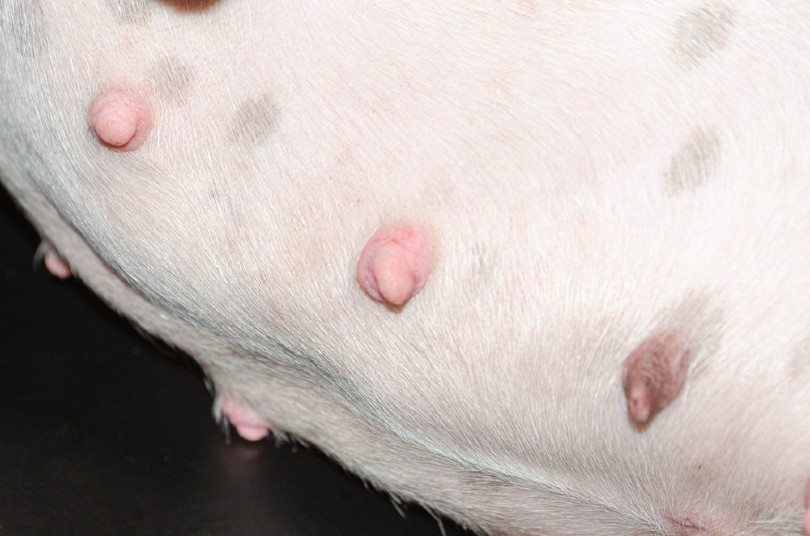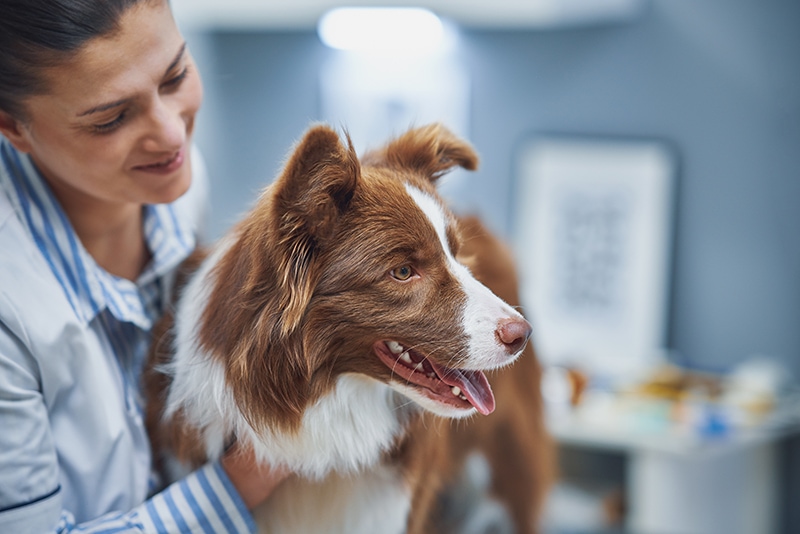Whether your dog was intentionally or accidentally bred, it can be challenging to determine if your dog is actually pregnant. Illnesses, pseudopregnancies, and behavioral changes can all mimic signs of pregnancy, making it very difficult to ensure you’re actually dealing with a pregnancy.
If your dog exhibits any of the following signs, they need to be evaluated by a veterinarian to rule out medical problems. Even if you feel confident that your dog is pregnant, they should see a vet to verify the pregnancy and begin planning for the pre- and post-partum periods.
Some things to be aware of:
The normal gestation period for dogs is around 63 days (9 weeks), so it is helpful to know when your dog was mated. As fertilization may not happen immediately, it is not unusual for whelping to be a few days over the 63, but if you reach day 65 and are not seeing any signs of preparing for birth (nesting, licking) then it’s time to check with your vet.
Pseudopregnancies, also known as false pregnancies or phantom pregnancies, occur when a mating has taken place but there is no pregnancy. Mating can stimulate a hormonal reaction that tells the body to start preparing for pregnancy (enlarged nipples, lactation, abdominal swelling) without actually being pregnant. Usually, these signs resolve on their own, but in some cases, dogs can need treatment to stop the pseudopregnancy.
The 9 Signs That Your Dog Might Be Pregnant
1. Swollen Nipples
Changes to the nipples and mammary glands are often the first, and the last, thing to reflect pregnancy in the bitch. It is quite common to see mild mammary development occurring shortly after mating, especially if this is her first pregnancy. This can also occur in cases of pseudopregnancy, so is not a reliable indicator of pregnancy.
As the pregnancy progresses, her nipples will begin to swell. This is due to hormonal changes that are getting the body ready for lactation and feeding a litter of pups. The mammary tissue and nipples can become very enlarged towards the end of the pregnancy, and should start producing milk from around 7 days before whelping.
Extremely enlarged, painful, red nipples, may be an indicator of mastitis, which is a painful infection. Mastitis is much more likely in a post-partum dog than in a pregnant dog, but it can occur. If you know that your dog is not pregnant, swollen nipples should be looked over by a vet as mammary cancer is relatively common in female dogs.

2. Swollen Abdomen
The obvious change you might see in a pregnant dog is swelling of the abdomen, particularly in lean dogs, though this change is often not seen until the final few weeks. This swelling is likely to make the dog look rounder, and if the dog is a healthy weight to begin with, she may lose her narrow waist when viewed from above.
Abdominal swelling is not a reliable indicator of pregnancy, however, and there are many other health conditions that can cause abdominal swelling, so if you are not sure your dog is (or should be) pregnant, they should be examined by your vet, particularly if the swelling has occurred rapidly.
Another potential cause of a swollen abdomen in a bitch following their season is a uterine infection, called Pyometra. The uterus fills with pus and can cause the abdomen to appear swollen. Dogs with pyometra will usually show other signs of illness such as increased thirst, lethargy and inappetence. This is a life-threatening condition and needs to be treated, usually with an ovariohysterectomy (spay). Often there will be a discharge from the vulva (open pyometra) to give an indication of the condition, but with a closed pyometra, the infection stays trapped inside and carries a high risk of uterine rupture and peritonitis.
3. Weight Gain
Growing babies inside of the body can lead to weight gain in dogs, just like it can in people, and indeed your dog should gain some weight throughout her pregnancy. If she doesn’t seem to be gaining weight, you likely need to increase her food consumption, ensure she is eating high-quality food formulated for puppies and pregnant or lactating females, and have a vet check her health status.
Females that don’t gain weight during pregnancy are often not receiving enough nutrition. Even for a dog pregnant with a singleton pup, weight gain is to be expected.

4. Low Energy Levels
Growing puppies takes a lot of energy! It’s very common for female dogs to have decreased energy levels when they’re pregnant. She may overall have low energy levels, or your dog may simply experience getting tired more quickly with activity. Both of these are not uncommon signs of pregnancy.
You should work to keep your dog active throughout her pregnancy, though. While activity likely needs to decrease in intensity and your activities may need to change, keeping your female active throughout her pregnancy will help keep her healthy and make labor and the post-partum period easier on her.
5. Loss of Appetite
Early in pregnancy, many female dogs will experience a loss of appetite. This can be due to nausea, hormones, low energy, or a general sense of malaise. If your dog stops eating for more than one to two days, she should be seen by a vet, whether you know she’s pregnant or not.
Even though your dog’s appetite may decrease in the early stages of pregnancy, she should always be offered plenty of high-calorie food to help support her throughout the pregnancy. If she is still exhibiting a poor appetite after a week or so, she should see a vet to rule out other medical issues. Loss of appetite shouldn’t exclusively be used to determine pregnancy since it can be associated with so many other conditions, such as pyometra.

6. Irritability
We all get grumpy sometimes, even dogs, but pregnant females may be more likely to seem irritable. This can happen in the sweetest dogs and is likely due to hormonal changes. Pregnancy hormones can make the protective nature of your dog really come out, and she may feel threatened or bothered by things that normally wouldn’t be an issue, like other pets in the home or children. Your dog also may be irritable simply because she isn’t feeling very good.
While irritability and touchiness can be normal, overt aggression, especially in a dog that hasn’t previously shown aggression, should be investigated by your vet.
7. Nausea and Vomiting
We’ve all heard of women experiencing morning sickness during pregnancy, and hormone-related nausea and vomiting can occur in dogs as well. It is less common than it is in humans, but some dogs may experience unusual nausea and vomiting, especially in the earliest days of their pregnancy.
If your dog is unable to keep food down or shows signs of nausea all the time, like drooling, inappetence, and abdominal discomfort, then she should see a vet. Your dog may need medication to help manage her nausea, but it’s also important to rule out other medical conditions causing nausea.

8. Increase in Affectionate Behavior
While some dogs become irritable during pregnancy, others will show a marked increase in affectionate behaviors. In some cases, your dog may show irritability toward other animals or noisy children, while showing you more affection than normal. This affection can be related to hormones and maternal instincts, as well as simply looking to you for comfort. If your dog becomes more snuggly than usual or suddenly becomes a “Velcro dog” that follows you around everywhere, then it’s likely due to her pregnancy.
9. Nesting
Dogs have an instinctual desire to create a safe space to have their puppies. The behavior associated with creating a safe and comfortable whelping space is called “nesting”. Nesting can involve a variety of behaviors, including digging, moving blankets and bedding to different areas, and restlessness.
If your dog is pregnant, you should provide her with a safe and comfortable whelping box where she can have her pups and they can be kept safe. A whelping box should be comfortable, but it should also be safe and designed to prevent puppy suffocation.
Ways to Determine Pregnancy in Dogs
1. Ultrasound
While women can get an ultrasound pretty early in their pregnancy to verify they are pregnant, ultrasound is an unreliable indicator of pregnancy in dogs until they are around days 25 to 35. Ultrasounds can view the puppies, help determine the number of pups, and allow the vet to see the fetal heartbeats. While it can help verify the health of the pregnancy, it is often not considered the best way to determine litter count.
2. Labwork
There are multiple hormones related to your dog’s heat cycle and pregnancy. If you intentionally bred your dog, then you are likely already familiar with some of the hormonal testing that helps determine when your dog is most likely to become pregnant. Around days 25 to 30, hormonal testing can help determine if your dog is pregnant. There are also pregnancy tests, much like the ones used by humans, but these are typically considered to be pretty unreliable.

3. X-Rays
Near the end of your dog’s pregnancy, an X-ray is the most reliable way to verify the number of pups. If you do an X-ray too early, the puppies’ bones will not have calcified yet, which means they won’t show up on the X-ray. For an accurate X-ray to determine pregnancy, you should wait until around day 55 of the pregnancy. However, exposing mom and pups to x-rays should be avoided unless essential.
4. Abdominal Palpation
Abdominal palpation is a fairly unreliable method, but in very lean dogs, sometimes the fetal sacs (in earlier pregnancy) or the pups can be palpated through the abdominal wall.
In Conclusion
Having a pregnant dog can be an exciting and stressful time. Being prepared and informed are the best ways to get your dog safely through her pregnancy, labor, and puppy rearing. We advise talking to your vet or qualified veterinary nurse about what to expect, what to be feeding, and any other questions you may have.
If you don’t intend to breed your dog, keep in mind that male dogs can be extremely persistent and creative when it comes to getting to a female dog in heat. Preventing pregnancy can be difficult, so consider your options and talk to your vet about having her spayed. Spaying can also reduce her risks of mammary cancer and eliminate the risk of pyometra.
Featured Image Credit: Jan-Dix, Shutterstock












